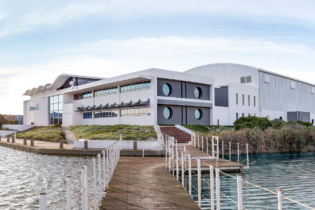Wastewater and biosolids treatment processes are increasingly being modified for the generation of biogas, offering a source of energy to generate power and heat. Maryke Foulds speaks to Dr André van Niekerk and Theunis Duminy at Golder Associates.
Golder is a global consulting organisation that provides a wide range of independent consulting, engineering and construction services in the specialist areas of earth, water, environment, energy and, more specifically, how to turn a wastewater plant into a sustainable enterprise from an energy perspective. Following the successful commissioning of a combined heat and power plant by Johannesburg Water recently, Van Niekerk (principal for mine and industrial water treatment) and Duminy (who heads up its water engineering division) are of the view that this technology will not only save on electricity costs, but crucially reduce water service authorities’ reliance on supplied power during power-supply interruptions. This is an important factor when considering what is needed to keep essential treatment equipment and processes running smoothly. Implementing this modern-day technology as part of a more holistic wastewater treatment strategy, also enables wastewater treatment works (WWTWs) to decrease their carbon footprint. “WWTWs globally – and increasingly in South Africa – have a long-term vision to be energy neutral,” says Van Niekerk. “Currently there is no facility that has yet achieved this on a continuous basis, but it is technologically feasible and definitely financially viable. It is forecasted that by 2025, there will be WWTW that will not only be energy neutral, but will be able to export excess power onto the grid.” Golder is at the forefront of this innovative application of technology and expertise. The knowledge of generating biogas and converting it to heat and electricity is not new, but South Africa is to a large extent only now realising the full potential of the impact thereof on energy and the running costs at WWTWs. While the process itself is essentially straightforward and technically proven, one of the biggest aspects of such a project is retrofitting an existing plant to be able to run efficiently as a biogas to power facility.“In the past, wastewater as a commodity was approached purely in terms of regulatory compliance and was seen as a cost item by water services authorities,” Van Niekerk says. “It is, however, now approached as both a business cost driver and an environmental/social reputational issue. As a global company, Golder can tap into global expertise to assist in the planning phases of such an upgrade or expansion.”
Golder’s global operations have been instrumental in assisting with technology transfer. In that sense Golder, in conjunction with South African industry, are on the cutting edge of introducing this type of technology to the South African market. Sludge optimisation and the bottom lineDuminy concurs: “Another factor to consider is how to condition sludge to optimise available treatment capacity. Through processes such as cell lysis, electrical pulse and sonic technologies, waste sludge can be pre-conditioned to enhance biogas production in anaerobic digestion. “The use of cell-lysis technology in the application of biogas-to-energy for WWTWs is most certainly unique in South Africa and Johannesburg Water is the first water utility to make use of such ground-breaking technology in the municipal sector. In essence the business case for biogas stands on two legs: the capital question on what it will cost to retrofit an existing wastewater facility and install a biogas-to-energy plant; and the life cycle question on what the payback period would be based on the annual cost saving in electrical power. To optimise the business case, municipalities must carefully look at the sources of sludge, how to optimise and pre-condition, as well as the facilities which will be retrofitted to maximise biogas-to-energy production.” In orderto maximise energy output, a precleaned gas supply needs to be assured. There are three compounds of specific concern in biogas that are detrimental to gas engines. Hydrogen sulphide in a gas engine can oxidise and form sulphuric acid, which is detrimental. Any moisture is detrimental to equipment – the gas must be dry. Another compound or group of compounds called saloxanes (silica derivatives) are contained in the gas. If it gets into the gas engine and is fired at very high temperatures, it can form hard glassy deposits with obvious serious impacts on the life of engines. Effective pre-treatment and the removal of all contaminants from the gas stream is crucial for optimal functioning – impacting directly on a reasonable pay-back period and equipment life. Moving on towards the actual implementation and financing of such a project, Duminy says: “The funding approach has a significant impact on the best contractual approach. There are various funding options that can be considered that ranges from the municipality or metro’s own revenue funds, grant funding or co-funding tied to an operations and maintenance approach.” With the latter, the operator needs to ensure that his equipment and installation is performing to a predetermined set of criteria reflected in contractual penalties and incentives. Given the potential scale of project, a public-private partnership approach is also feasible, although these are limited in the municipal water sector in South Africa. Due to the specialised equipment, proprietary pre-treatment approaches and performance requirements of such an installation, this type of facility requires a contractual approach that optimises the design, building, operating and maintenance thereof within a defined battery limit and operating range. It has been estimated that the running cost of a WWTW in South Africa could double in real terms between now and 2020, a trend driven primarily by the increasing cost of energy. Increasing operational costs provides for a very strong business case to drive these biogas-to-energy projects. In the municipal sector, where a focus on capital investment has dominated in the past, a change towards evaluating projects holistically is gaining ground. Utilities and municipalities are starting to look at the life cycle costing rather than just the initial capital outlay. The fact does remain that a biogas-to-energy plant can pay for itself within five years if all the right criteria are in place.








